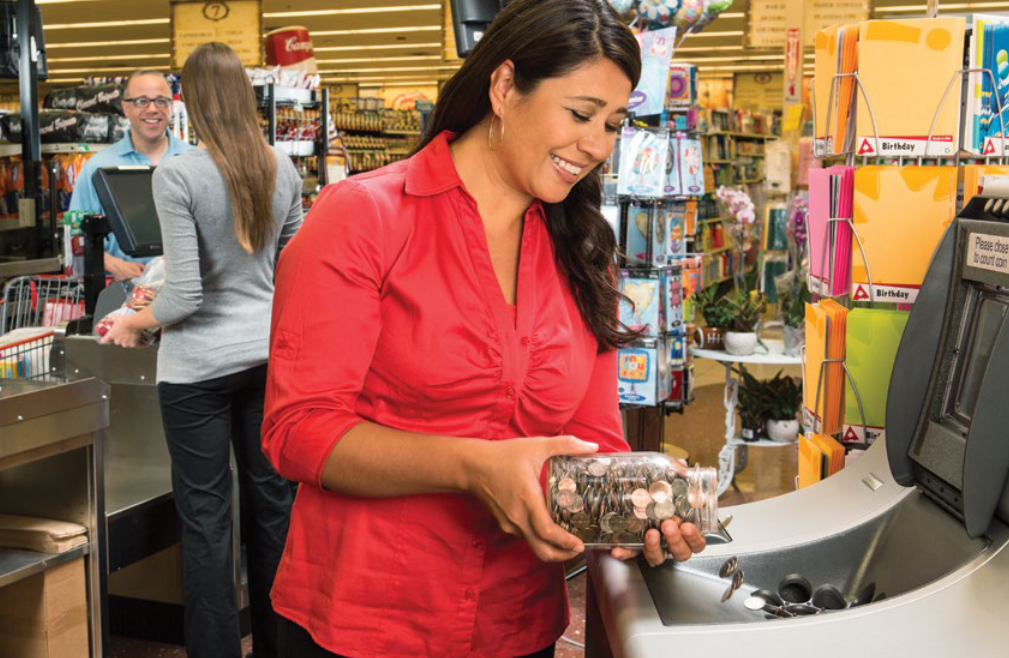The fastest, most reliable and highly accurate coin counter machine. Coinmax™ is a self-service coin counting machine which is fast, highly accurate, easy to use and best of all…affordably priced.
Make the most of coin-saving habits and leverage the high demand for coin redemption by adding a coin counting machine to your business.
- Financial institutions benefit from increased branch traffic, enhanced customer loyalty and improved teller line efficiencies.
- Grocery stores can make more profit as well as improve customer service by adding a reliable and easy-to-use coin counting machine to their storefront.
- Gaming establishments can free-up cashiers, generate incremental revenue and recycle coin in-house.
All models feature:
- Against the wall or through the wall configurations
- DIP card reader for direct deposit options at credit unions or banks
- On-screen advertising for promotions and up-selling with sound and video
Features
- Bin or bag-style coin collection options:
– Single bin – 70,000 mixed coin capacity
– Dual bin – 140,000 mixed coin capacity
– Bag capture with 8 or 16 sorted bags
– 78,000 coins total in 16 bags
– 36,000 coins total in 8 bags
– Bag capture with 16 mixed bags – 80,000 coins total
- Enhanced coin discrimination: suspect coins are uncounted and diverted to a coin-return cup instantly with no interruption to sorting. Accuracy is a critical component in coin processing. When properly operated and maintained Coinmax™’s high-precision coin discrimination technology differentiates coin more precisely, providing more accurate totals.
- Advanced debris management: non-coin debris such as paper clips, screws, bolts and bent coin are diverted to a debris cup for easy disposal, preventing interference with coin processing.
- Efficient bag management: simpler, more intuitive bag management screens present full bags to the attendant without reaching into the machine for access. Enables faster bag changing making less work for attendant and machine is back in service quickly.
- Multiple user fee options: provide multiple levels of consumer-defined user fees. Includes the ability to waive fees for account holders, assess fees for non-account holders and set transaction limit amounts to determine when user fees are applied.
- Extensive transaction reporting: allows for the monitoring of tasks performed, transaction histories, usage and machine statistics for management reports.
- Multiple languages: allows custom tailoring of language to your consumers.
- Customizable transaction receipt: your logo or message can be printed on the top and bottom of the consumer receipt.
- Coin program options: flexible coin program options let you buy, lease, rent or place a self-service coin counter in your store, branch, or casino.
Payback Math
While every business has a different payback calculation, this is just an example of what a grocery store could experience. Depending on leasing the coin counting machine or purchasing, expected payback on $2,800 a week in coin volume and a user fee of 11.9%, the years to payback are under 2.1 years.
Coin recycling is also critical. Business’ can reduce their purchased coin spend by recycling what comes through the coin counting machines.
This is the fastest, most reliable and highly accurate coin counter machine around. CoinMax is a self service solution and is fast, highly accurate and affordably priced.
GAD is a certified Crane Coinmax distributor. Our sales team can help you with the best locations for this machine and security tips and tricks.











